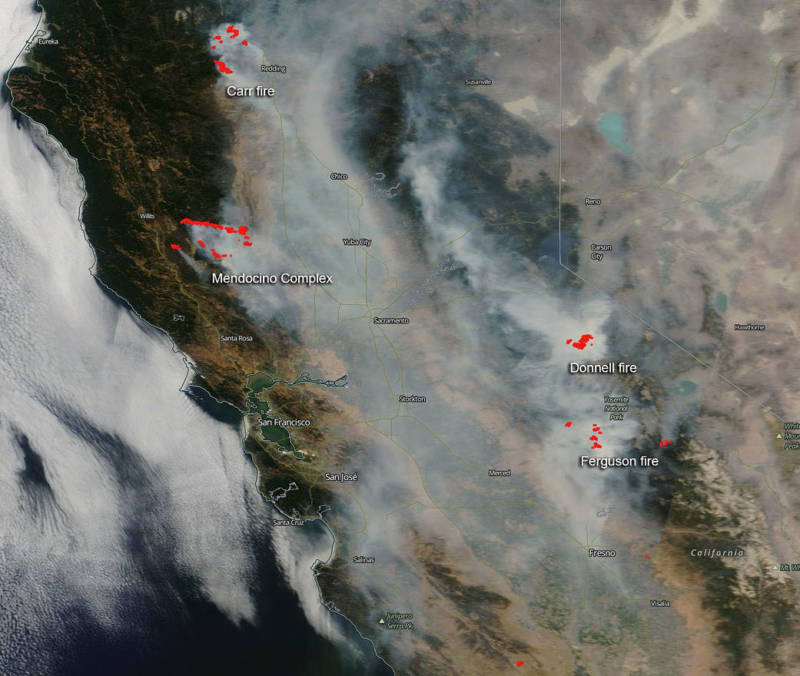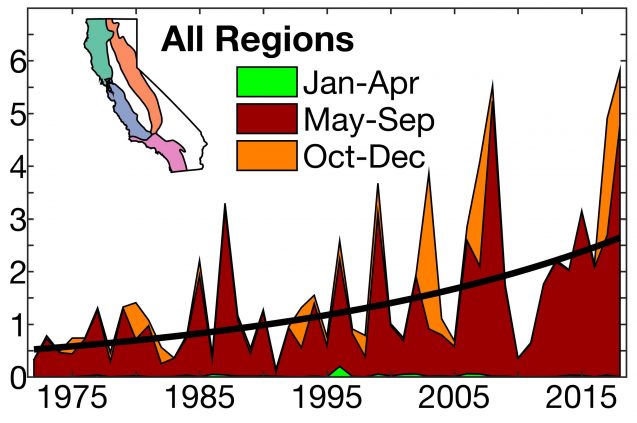California is heating up.
Study: Climate Change a Leading Driver of California's Wildfires

That heat is driving an increase in the land burned by California wildfires every year as the arid weather dries out forests along the North Coast and Sierra Nevada, according to new research that published this week in the journal Earth’s Future.
Summer forest fires are pushing up the annual burn rates across the state, according to Park Williams, the study’s lead author.
“We’ve seen a five-fold increase in areas of California that burn in any given year,” said Williams, a bioclimatologist at Columbia University’s Lamont-Doherty Earth Observatory. “But just in the summer forest fire areas, we have seen an eight-fold increase.”
California wildfire activity has been increasing for the last 50 years, and the dominant driver of the increase is warming that is “very likely human-caused climate change,” he said.
For years, scientists have said that climate change is baking California’s forests, but the wildfires are also driven by other factors, including forest management techniques and natural climate variation.
Disentangling all the wildfire drivers is complicated, but Williams calls climate change “decisive.”
Also, the new research suggests that arid and hot conditions, in particular, were key reasons for the devastating forest fires that burned in recent years. The Tubbs fire killed 22 people and burned 36,807 acres in 2017, and last year’s Camp Fire killed 85 people and torched an incredible 153,336 acres.
The two fires are the worst on record in California. Of the top 20 most destructive California wildfires, 10 have occurred since 2015. Of the top 10, seven have burned over the last four years.
“When we compare the records of forest fire areas in California against all the variables out there, the strongest correlation by far is the aridity of the atmosphere, and that’s driven by temperature,” said Williams.

Meg Krawchuk, a fire ecologist at the College of Forestry at Oregon State University, said the study is a thorough assessment of relationships between area burned and climate.
“It is incredibly important for all of us living in areas vulnerable to wildfire to more thoroughly appreciate how climate, and anthropogenic climate change more specifically, is contributing to the fires we’re experiencing in recent decades,” said Krawchuk, who was not involved in the study.
Jon E. Keeley, a fire scientist with the US Geological Survey, said he agrees that rising temperatures are drying out forests and playing a major role in the increase in wildfire activity during the summer. “The hot air dries out fuels and makes the forests more flammable,” he said.
But he disagrees with another portion of the paper that emphasized the role that climate change plays in coastal and Southern California. He said the problem is that people there are starting more fires, either intentionally or with infrastructure like power lines.
“When it comes to fire, climate is important but it’s not the only show in town,” said Keeley, who did not participate in the study. “I think the real issue is population growth. We’ve added 6 million more people in the last 18 years, you can’t overlook that and address that as an important factor. The increases in fire are, in large part, due to ignition during extreme wind events.”
To be sure, there are many reasons that fire threatens to unleash disaster and chaos in more California communities.
For one, forest managers suppress naturally-occurring fires. Federal agencies resist performing prescribed burns in California when they’re needed, which would curb the risk of wildfire.
Also, as wildfire-susceptible areas expand statewide, new Californians keep pouring into them. By midcentury, home builders may add as many as 1.2 million new units in geographic areas most at risk.
Those are major factors, but Williams reiterates that a warming climate is the most powerful lever. As the atmosphere heats up, it acts like a sponge, soaking moisture out of the state’s forests — which increases the risk of a fire.
The warmer the atmosphere gets, the more moisture it can pull out of forests. Each degree of warming does more to promote fire than the previous degree, according to Williams, who said that large fires are likely to become increasingly frequent with continued warming.
Californians can learn to survive wildfire in a warming world. It will mean big changes in how we think and live. Read some of the stories of people leading the way in communities across the state here.
